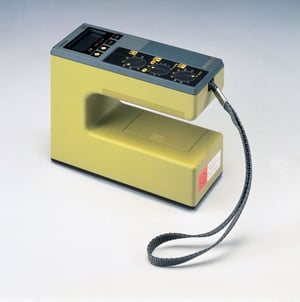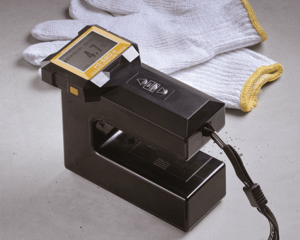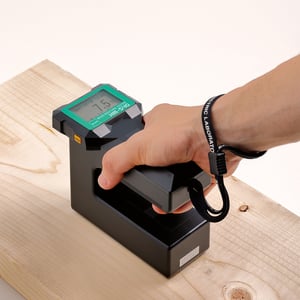.jpg?width=300&height=221&name=kwon-junho-lwmPOZ5nUfk-unsplash%20(1).jpg) Hardwood floors are an enduring, timeless option that many homeowners and business owners choose to create a variety of looks. Depending on the design, finish, and stain, wood floors can be trendy, elegant, chic, or cozy.
Hardwood floors are an enduring, timeless option that many homeowners and business owners choose to create a variety of looks. Depending on the design, finish, and stain, wood floors can be trendy, elegant, chic, or cozy.
But hardwood floors also can present some unique challenges for installers that other types of flooring like carpet, laminate, and tile don’t have. One of the most significant considerations when installing hardwood flooring is its moisture content.
Issues with too much moisture in the wood or subfloor of hardwood floors can cause boards to peel away from the subfloor, create noticeable defects and imperfections, and even result in unsightly discoloration. Contractors and installers should have accurate, reliable, easy-to-use instruments on hand, including wood and concrete moisture meters, to ensure the finished hardwood floors are just as beautiful and long-lasting as they envisioned.
Testing Moisture in Wood Flooring
Many wood flooring manufacturers recommend allowing the wood to acclimate to its surroundings before installation. This is because wood is hygroscopic, which means it takes on the moisture of its environment, which can impact its dimensions and impact installation.
If wood flooring takes on or loses moisture, it causes the wood to change. Depending on the moisture content of wood flooring, it can:
- Expand
- Shrink
- Buckle
- Check
- Split
If the wood absorbs too much moisture from its environment, boards can expand or swell, resulting in a “cupped” or “swollen” appearance. Additionally, boards can push against fasteners when they swell, leading to squeaky floors and loose floorboards.
Some wood floors are glued down. Shifting moisture content after installation can also impact these floors. Excessive moisture in glued floorboards can mean that as the boards expand, they stretch out the adhesive, resulting in adhesive failure. However, if flooring loses moisture and dries out, the boards can shrink, creating gaps in between each board.
 Ideal for testing the MC of wood flooring materials is the HM530 Non-Destructive Wood Moisture Tester, which takes accurate readings of the moisture content of wood without the use of destructive pins. The HM530 delivers instant, accurate results through the use of a high-density coil, which produces high-frequency capacitance to measure changes in the dielectric constant of the sample, and can be adjusted for various temperatures and wood thicknesses.
Ideal for testing the MC of wood flooring materials is the HM530 Non-Destructive Wood Moisture Tester, which takes accurate readings of the moisture content of wood without the use of destructive pins. The HM530 delivers instant, accurate results through the use of a high-density coil, which produces high-frequency capacitance to measure changes in the dielectric constant of the sample, and can be adjusted for various temperatures and wood thicknesses.
Testing Moisture in the Subfloor
It’s not just the moisture levels of the wood flooring that matters—it’s also the moisture level of the subfloor below it. Wood flooring manufacturer 50 Floor recommends that any subfloor with a moisture content above 12% is just too wet for flooring installation. In fact, the moisture content of the subfloor should be somewhere between 7 and 9%.
This manufacturer also recommends the use of a moisture meter to test moisture levels before installation, suggesting that installers should take readings in 20+ locations per 1,000 square feet of flooring, then average these results to get a good overview of the overall moisture range. What’s more, they share that the moisture content of the wood flooring should be within 2 and 4% of the subfloor’s moisture level.
If the subfloor’s moisture content (MC) level is below 12% and the floorboards are within 2 to 4% of this moisture level, it’s acceptable to install flooring without additional acclimation time. But what happens if the subfloor and floorboards are not within this moisture content range?
- For subfloors that have an MC below 12%, but the wooden floorboards are not within an acceptable MC range, the floorboards should be acclimated for an additional seven to ten days.
- Subfloors with an MC above 12% should be dried before installing hardwood floors.
Some hardwood floors are installed on plywood or other similar products, for which the HM530 Non-Destructive Wood Moisture Tester is a natural choice to assess the MC of the subfloor. However, not all subfloors are made of wood. One thing to keep in mind is that many subfloors are concrete, a product that requires its own careful drying and curing process, which may vary from season to season. Not only can the moisture content impact hardwood floors, but it can also affect the strength and durability of a concrete subfloor. For these reasons, a moisture meter like the HI520-02 Concrete and Mortar Moisture Meter should be used to accurately assess the MC of concrete before installing wood floors.
The HI520-02 Concrete and Mortar Moisture Meter can test concrete’s moisture levels even after it hardens to prevent issues with the concrete or the hardwood planks above it. This moisture meter comes equipped with a range of highly accurate factory calibrations for quick readings. It’s also portable, making it ideal for on-site installations.
The Kett team has been supporting woodworkers, carpenters, contractors, and other installers with the highest-quality instruments they need to deliver first-rate flooring installation for decades. We’ll provide you with the instruments and answers you need to help you confidently create beautiful homes and floors. To learn more, connect with our team of expert engineers today.



